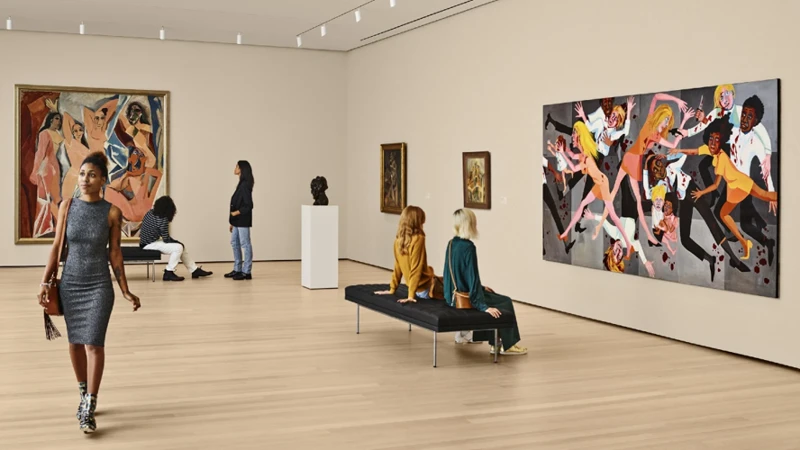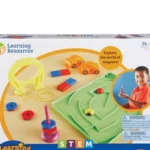Art Beyond Canvas: Museums Showcasing Unique Art Forms
In the ever-evolving world of visual arts, the boundaries of artistic expression have expanded far beyond the traditional medium of paintings on canvas. Today, artists are venturing into uncharted territories, pushing the limits of creativity and exploring new avenues to captivate audiences. From mesmerizing installations to thought-provoking sculptures, digital art displays to captivating performance pieces, the possibilities seem boundless. This article delves into the exciting realm of art beyond the canvas, highlighting how museums around the world are embracing these unique art forms and inviting viewers to engage with art in ways that challenge perceptions and stimulate profound emotions. As we venture into the future, the world of visual arts holds endless possibilities, with artists continuously pushing boundaries and redefining the limits of artistic expression. Join us on this journey as we delve into the fascinating world of art beyond the canvas.
Contents
- MoMA and Abstract Expressionism
- MoMA Expands
- Conclusion
-
Frequently Asked Questions
- What are some unique art forms showcased in museums today?
- How are museums embracing art forms beyond the canvas?
- What is the significance of exploring contemporary ideas in art museums?
- How do museums feature artists from around the globe?
- How do museums merge tradition with innovation in their exhibitions?
- How does MoMA expand its exhibition offerings?
- What is the benefit of expanding museum exhibitions?
- How do museums invite viewers to engage with art in unique ways?
- How can viewers challenge their perceptions through art beyond the canvas?
- What does the future hold for art beyond the canvas?
- References
MoMA and Abstract Expressionism

MoMA, or the Museum of Modern Art, has played a significant role in the recognition and promotion of Abstract Expressionism. While the Abstract Expressionist Exhibit at MoMA has its highs and lows, it offers visitors a chance to explore their views on abstract art. The exhibit features the energetic work of Jackson Pollock, whose unique style captivates viewers. However, some may find the works of Mr. Newman and Mr. Rothko lackluster. Despite this, MoMA’s acceptance of the so-called New York School, showcased in curator Dorothy Miller’s 15 Americans show, marked a turning point for the museum. MoMA’s commitment to keeping their collection relevant led to the expansion of the museum and the creation of the Abby Aldrich Rockefeller Sculpture Garden. While MoMA houses a formidable collection of Abstract Expressionist works, other museums also boast significant pieces. The Met’s Muriel Kallis Steinberg Newman Collection, for example, is recognized as one of the preeminent collections of Abstract Expressionist art in the country. MoMA’s role in promoting Abstract Expressionism cannot be understated, but it is important to acknowledge the presence of important works in other museums as well.
Exploring Contemporary Ideas
Contemporary art is a reflection of the modern world, capturing the complexities and intricacies of life in this moment in history. Artists today are constantly innovating and creating exciting artworks that respond to the ideas and issues of our time. These artworks challenge viewers’ expectations and artistic conventions, offering new perspectives and pushing the boundaries of what art can be.
One example of a groundbreaking contemporary artwork is Yoko Ono’s “Cut Piece,” created in 1964. This performance artwork took place in New York City and involved Ono sitting still while members of the audience were invited to cut pieces of her clothing. This piece not only defied traditional notions of art but also engaged with ideas of vulnerability, power dynamics, and the relationship between the artist and the audience.
Contemporary artists also embrace the concept of artistic pluralism, rejecting the notion of mainstream art and exploring a variety of styles, materials, and sources. They draw inspiration from various movements, such as performance art, pop art, conceptual art, and video, to create their unique artworks. This diversity and openness in contemporary art make it difficult to categorize or summarize, as each artist brings their own perspective and approach.
When experiencing contemporary art, viewers are encouraged to approach it with an open mind. Instead of solely focusing on aesthetics, they are invited to engage with the ideas and concepts presented by the artist. This shift in perspective allows for a deeper understanding and appreciation of the art of our era.
The Getty Center is one of the museums showcasing contemporary art, offering a platform for artists to explore and express their ideas. Through exhibitions and displays, the museum invites viewers to question the relationships between art and politics, the role of institutions in society, and the ways art can exist outside of capitalist economies. The contemporary artworks on view at the Getty Center represent a diverse range of ideas and themes, inviting viewers to engage with the complexities of the world we live in.
Exploring contemporary ideas in art goes beyond traditional mediums and conventions. It challenges us to think critically, to question the status quo, and to consider new perspectives. By embracing the ever-evolving world of contemporary art, museums are creating spaces for dialogue, reflection, and inspiration. As we continue to navigate the future, art beyond the canvas will continue to evolve and captivate audiences, offering new possibilities for artistic expression and cultural exploration.
For more information on visiting museums as a student and discovering the world of art, check out our guide on museum tips for students.
Artists from Around the Globe
In the ever-expanding landscape of artistic expression, artists from around the globe are making their mark on the art world. Through their innovative and diverse creations, they challenge traditional notions of what art can be. From the bustling streets of Tokyo to the vibrant markets of Mexico City, these artists draw inspiration from their unique cultural backgrounds and experiences.
One such artist is Osamu Shiihara from Japan, whose photograph from the 1930s depicts shampooed hair as uncanny tendrils. This intriguing piece pushes the boundaries of Surrealism, hinting at efforts to expand the geography of artistic movements beyond Europe and the Americas.
Another noteworthy artist is Elizabeth King Hawley, a self-taught artist whose Hanging Sphere (ca. 1875) captivates viewers with its circular tent-like structure. This enigmatic sculpture, along with other works by self-taught artists, was included in MoMA’s landmark exhibition “Fantastic Art, Dada, and Surrealism” in 1936, which explored the fascination with the irrational in the avant-garde art world.
The exhibition “Masters of Popular Painting: Modern Primitives of Europe and America” (1938) showcased the works of self-taught artists like John Kane, Joseph Pickett, and André Bauchant. These artists, often overlooked by the mainstream art world, brought a fresh and untrained perspective to their creations, challenging the notion of what it means to be an artist.
By showcasing the works of artists from diverse backgrounds and traditions, museums like MoMA embrace the ever-expanding global art scene. They recognize that creativity knows no boundaries and that art is a universal language that transcends cultural differences. Through these exhibitions, viewers have the opportunity to explore different perspectives and gain a deeper understanding of the rich tapestry of artistic expression from around the world.
As museums continue to evolve, they play a vital role in fostering cultural exchange and appreciation. By showcasing artists from around the globe, they provide a platform for these talented individuals to share their unique visions and narratives. This global dialogue not only enriches the art world but also promotes understanding and empathy among diverse communities.
So, as you embark on your own artistic journey, consider exploring the works of artists from around the globe. Their captivating creations will challenge your perceptions, stimulate your imagination, and ignite a sense of wonder. Step into the world of art beyond the canvas and discover the endless possibilities that await.
To further explore the world of museums and art, check out our guide to student-friendly museums. It’s a great resource for students looking to immerse themselves in the vibrant world of art and culture while taking advantage of student discounts.
Merging Tradition with Innovation
In the ever-evolving landscape of art, museums are embracing the concept of merging tradition with innovation. This approach allows for the exploration of new and exciting art forms while honoring the rich heritage of artistic traditions. By combining elements of the past with contemporary ideas, museums are creating a dynamic and thought-provoking environment for viewers.
One example of this merging of tradition with innovation can be seen in the recently reopened Museum of Modern Art (MoMA). With its revamped galleries, MoMA is showcasing a diverse range of artworks that challenge traditional notions of art. From the spiritual center of the museum, where works by Miró, Picasso, and Magritte are displayed alongside artists like Kahlo, Oppenheim, and Carrington, to the inclusion of self-taught artists and mentally ill artists in past exhibitions, MoMA is actively reexamining the canon-formation process.
The museum’s commitment to merging tradition with innovation can be seen in its decision to change major sections of the permanent collection galleries every six months. This approach reflects a more open and critical approach to the institution’s own historiography, allowing for the inclusion of lesser-known artists and challenging the notion of what constitutes a masterpiece.
In addition to MoMA, museums around the world are also embracing the merging of tradition with innovation. They are actively seeking out and showcasing artworks that transcend the traditional canvas. Installations, sculptures, digital art displays, performance art, and mixed media projects are just a few examples of the diverse range of art forms being explored.
By merging tradition with innovation, museums are creating spaces that invite viewers to engage with art in new and exciting ways. They are provoking emotions, stimulating thoughts, and challenging perceptions. This approach not only pushes the boundaries of artistic expression but also invites viewers to question and reimagine what art can be.
As we continue into the future, the possibilities for art beyond the canvas are endless. Artists will continue to push boundaries, redefine the limits of artistic expression, and inspire us with their creativity. Museums play a vital role in showcasing these unique art forms, and their commitment to merging tradition with innovation ensures that the world of visual arts remains vibrant and ever-evolving.
Join us on this journey as we explore the fascinating world of art beyond the canvas and discover the endless possibilities that lie ahead.
[Link to “Unleashing Creativity: Museums as Inspiration for Student Artists”](unleashing-creativity-museums-inspiration-student-artists)
MoMA Expands
In the ever-evolving world of visual arts, museums play a crucial role in showcasing unique art forms that go beyond traditional paintings on canvas. One museum that is leading the way in this exploration is the Museum of Modern Art (MoMA). MoMA recognizes the need to expand its exhibition space to accommodate a diverse range of artists and their works. With the acquisition of the American Folk Art Museum and the construction of a new residential tower, MoMA is set to dramatically increase the number of works it can showcase. This expansion not only provides more space, but also allows for a rethinking of the experience of art in the museum. The curators at MoMA are committed to spotlighting the work of women, African American, Asian, and Latino artists who have been previously overlooked in the collection. By breaking down the divisions between departments and presenting all mediums side by side, MoMA aims to provide a comprehensive view of contemporary art. MoMA is partnering with the Studio Museum in Harlem to host programs and exhibitions, highlighting the importance of collaboration and inclusivity in the art world. With these exciting developments, MoMA is embracing the ever-changing landscape of art and offering viewers new perspectives and fresh voices to explore.
Expanding the Exhibition
In order to provide a more immersive and diverse experience for visitors, the Museum of Modern Art (MoMA) has undertaken a significant expansion project. This expansion not only includes additional exhibition space, but also a fresh approach to showcasing art.
Led by architects Diller Scofidio + Renfro in collaboration with Gensler, the expansion takes advantage of the 40,000 square feet of additional space. This allows curators to rehang the collection in a way that highlights the work of women, African American, Asian, and Latino artists who may have been previously overlooked.
The goal of the expansion is to create a space that encourages visitors to rethink their experience of art. It is not just about more space, but about creating an environment that challenges perceptions and offers new perspectives. By spotlighting artists from various backgrounds and regions, MoMA aims to demonstrate that what was once considered peripheral is now central to the artistic conversation.
The expanded exhibition will feature original pieces created by the artists themselves, as well as limited edition photos of their work. Additionally, there will be a shop onsite where visitors can purchase limited edition and unique art pieces, as well as other merchandise such as posters and tote bags.
To accompany the exhibition, MoMA has published a comprehensive catalogue, featuring contributions from renowned curators and experts in the field. This publication includes over 400 illustrations, ranging from stunning color images to rare archival documentation.
As part of their commitment to safety, MoMA has implemented protocols for performers, who will be wearing masks and other personal protection items. This ensures a safe and enjoyable experience for all visitors.
The expansion of MoMA is an exciting development in the world of art, offering a fresh and inclusive approach to showcasing unique art forms. With its dedication to representing diverse voices and perspectives, MoMA invites visitors to discover new artists, engage with art in innovative ways, and expand their understanding of the artistic landscape.
Don’t miss out on this transformative experience – join MoMA today and be a part of the future of art.
Conclusion
In conclusion, the world of art has evolved significantly, expanding beyond the traditional canvas and embracing new forms of artistic expression. Museums play a vital role in showcasing these unique art forms, providing a platform for artists to share their innovative ideas and challenge societal norms. Through thought-provoking installations, captivating sculptures, and mesmerizing performances, museums invite viewers to engage with art in ways that stimulate deep emotions and foster critical thinking.
The value of art extends beyond its commercial success, as it serves as a provider of information and contributes to the overall well-being of society. Art appreciation involves reflection and critique, allowing individuals to gain a deeper understanding of the material and facilitating thought processes. Whether practical or purely aesthetic, art has the power to evoke a wide spectrum of emotions and bring beauty into our lives.
As the world continues to evolve, museums continue to expand and diversify their exhibitions. They aim to include artists from around the globe, merging traditional techniques with innovative approaches. This expansion not only brings fresh perspectives but also provides opportunities for discourse and cultural exchange.
For students and art enthusiasts alike, museums offer a wealth of inspiration and education. Whether on a budget or seeking hidden gems, there are numerous museums with student discounts and student-friendly options available. Exploring these museums can unleash one’s creativity and provide valuable insights into the history and science behind art.
As we navigate the ever-changing landscape of visual arts, it is clear that the possibilities are endless. Artists will continue to push boundaries, redefine artistic expression, and captivate audiences with their unique creations. Museums will remain essential in fostering appreciation and understanding of art beyond the canvas. Join us on this journey of exploration and discovery as we embrace the fascinating world of art beyond the traditional mediums. For more information and recommendations on museums, check out our guide to student-friendly museums and must-visit museums for students.
Frequently Asked Questions
What are some unique art forms showcased in museums today?
In addition to traditional paintings on canvas, museums now showcase a wide range of unique art forms, such as installations, sculptures, digital art displays, and performance pieces.
How are museums embracing art forms beyond the canvas?
Museums around the world are actively embracing art forms beyond the canvas by dedicating exhibition spaces to installations, sculptures, digital art displays, and performance pieces.
What is the significance of exploring contemporary ideas in art museums?
Exploring contemporary ideas in art museums allows viewers to engage with the current cultural and social landscapes, fostering a deeper understanding and appreciation of the world we live in.
How do museums feature artists from around the globe?
Museums feature artists from around the globe by curating exhibitions that showcase artwork from diverse cultural backgrounds, providing a platform for artists to share their unique perspectives.
How do museums merge tradition with innovation in their exhibitions?
Museums merge tradition with innovation by juxtaposing traditional art forms with contemporary interpretations, creating a dialogue between the past and the present.
How does MoMA expand its exhibition offerings?
MoMA expands its exhibition offerings by constantly curating new shows, featuring a wide range of artists and art forms, to provide visitors with diverse and enriching experiences.
What is the benefit of expanding museum exhibitions?
Expanding museum exhibitions allows for a broader representation of artistic voices and perspectives, fostering a more inclusive and dynamic art scene.
How do museums invite viewers to engage with art in unique ways?
Museums invite viewers to engage with art in unique ways by creating interactive installations, hosting performances, and providing educational programs that encourage active participation and dialogue.
How can viewers challenge their perceptions through art beyond the canvas?
Viewers can challenge their perceptions through art beyond the canvas by encountering unconventional art forms that provoke thought, evoke emotions, and push the boundaries of traditional artistic expression.
What does the future hold for art beyond the canvas?
The future of art beyond the canvas is full of endless possibilities, with artists continuously pushing boundaries and exploring new mediums and techniques to redefine the limits of artistic expression.







